I’m a full-grown woman with adult responsibilities and a pretty good head on her shoulders. Most of the time. But when I find powdery mildew on my roses, I just want to lie down, kick my heels in the grass, and throw a certified, grade-A tantrum.
I’m sure you already know this, but you don’t want powdery mildew on your roses. It’s bad news.
Beyond the potential to make your plant look kinda ugly, the pathogens that cause this disease can make your shrub fail to bloom and in the case of a bad infection, totally defoliate the whole thing. Plus, I can’t help but whine, it’s so freakin’ common!
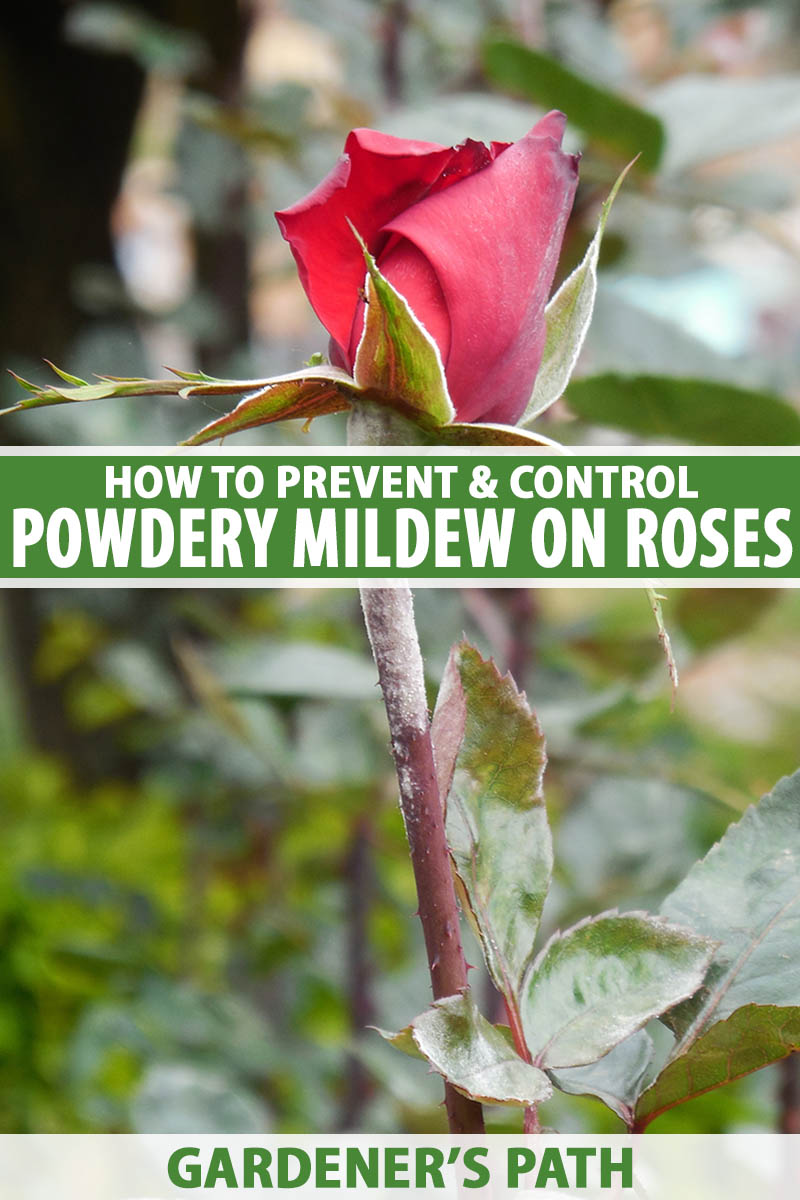
We link to vendors to help you find relevant products. If you buy from one of our links, we may earn a commission.
I think that’s why powdery mildew tends to bring out the worst in gardeners. Sooner or later, if you grow roses, you’re probably going to bump up against it. So when you see that telltale powdery coating on your plants, you just want to turn and walk away.
The saving grace is that we have a pretty good handle on stopping and even eliminating this disease, so it doesn’t have to ruin your whole year.
In this guide, we’ll share with you what you need to know to show powdery mildew the door. Here’s what’s ahead:
What You’ll Learn
If you’ve spotted a white dusting on your rose plants, I’m sure you’re panicking. Don’t! Keep reading to learn what to do.
What Is Powdery Mildew on Roses?
Powdery mildew is a common disease that infects hundreds of plant species, and it’s caused by dozens of different fungi. In roses, it’s caused by Podosphaera pannosa var. rosae, which was formerly known as Sphaerotheca pannosa var. rosae.
This pathogen loves hot days and cool nights, especially if there’s a lot of humidity. And don’t think you’re off the hook if you live in a dry climate. Tightly spaced plants and those that aren’t pruned regularly to thin them out can create a little humid microclimate in your garden.
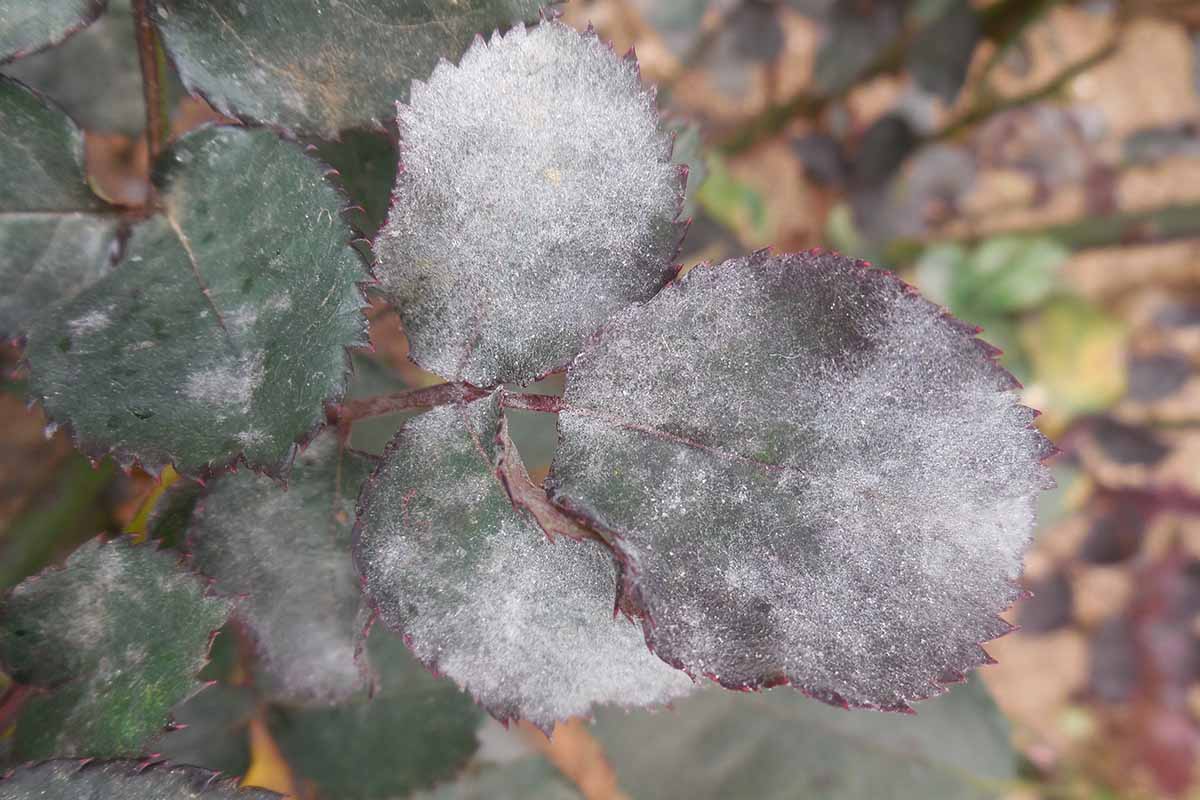
Unlike other species of fungi that need a wet environment to breed, P. pannosa will grow on dry leaf surfaces and if the spores become wet, they can’t complete their life cycle.
You can learn more about this process in our comprehensive guide to powdery mildew.
That means when there are dry days, high humidity, and hot days coupled with cool nights, it’s like laying out the red carpet for this pathogen. In most areas, these conditions are generally common in the spring, so that’s when you’ll usually see the disease.
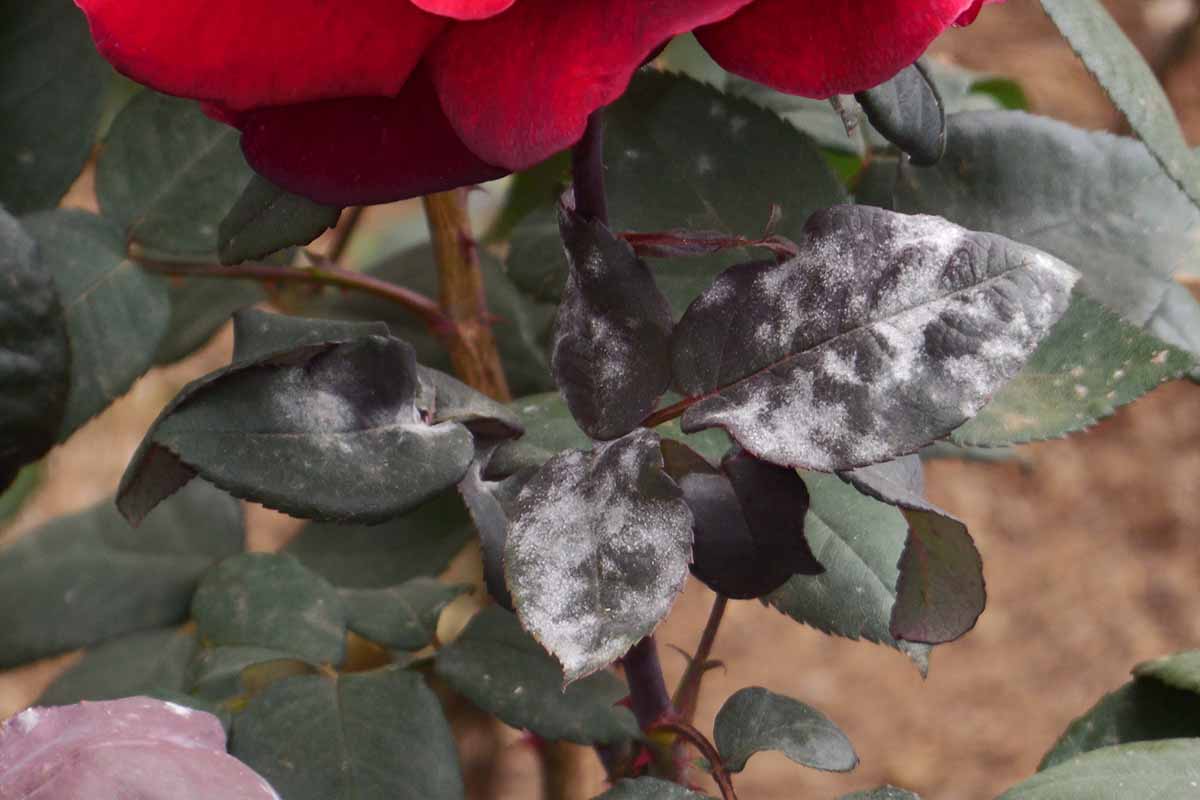
Powdery mildew must have living tissue in order for the fungus to mature and spread.
That gives us an advantage in both prevention and treatment. The bad news is that it only takes this pathogen up to three or four days to complete its life cycle when the environmental conditions are ideal.
Symptoms
Well before your roses fail to bloom and the leaves fall off, you’ll see some early symptoms.
If you catch the problem at this point, you have a good chance of heading it off before the infection becomes advanced. The more advanced the disease becomes, the harder it is to treat.
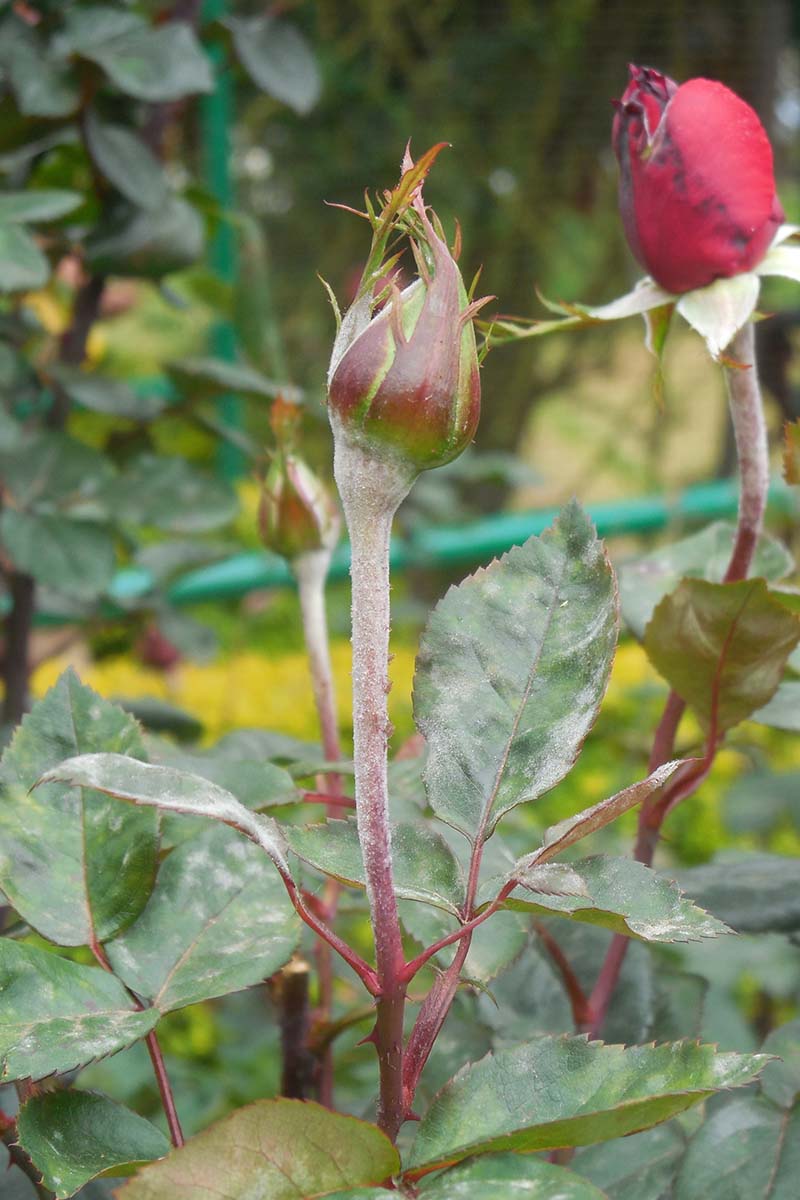
Look for red, blister-like growths on the upper sides of the leaves, followed a short while later by powdery fungal growth all over the upper and lower parts of the leaves, the flowers and peduncle (the stem that supports the flower), and the stalks. Usually, though not always, this powdery fungus shows up on new growth first.
It’s easy to tell the difference between powdery and downy mildew – the latter only appears on the undersides of the leaves. If the coating is on both sides or just the upper side, it’s powdery mildew.
Once the fungal covering is present, the next phase begins. The leaves will start to become distorted, and they’ll end up all curled and wrinkled.
When this happens, the leaves can’t do their job of taking in sunshine and turning that into energy to produce lovely blossoms and hips. In scientific terms, it means that photosynthesis can’t take place efficiently.
The result is that the flowers don’t form or, if they do, they’ll be pretty small and sad and not very abundant. Left unchecked, the final stage takes place. This is when all the leaves fall off and the plant is toast (not a scientific term).
Not all plants will progress through all of these stages. Some might never advance past the blister-like growths. But it’s best to assume that without treatment, the disease will become worse and worse and act accordingly.
Prevention
You should assume that this pathogen is always around, no matter where you live. It’s just biding its time, waiting for the right environmental conditions so it can come out and ruin your roses.
Then, work to deny it the conditions it favors.

The first step is to maintain good air circulation at all times. That means careful pruning, proper spacing between plants, and watering at the soil level and not on the foliage.
You should also water in the late morning so that the moisture can evaporate quickly rather than remaining on the surface of the soil, creating a humid environment.
The exception is if you want to water carefully in the afternoon as a preventative tactic to disrupt the disease cycle. If you do this, wait for a warm, sunny period and spray the plant down thoroughly. The goal here is to wet the leaves without creating lasting humidity.
Always clean up fallen leaves in the autumn so the dormant spores don’t have a place to overwinter. You can also mulch the soil around your plants to add an extra layer of protection between the soil and the foliage.
You can also choose resistant cultivars such as ‘Altissimo,’ ‘Carefree Spring,’ ‘Jeanne Lajoie,’ ‘Sally Holmes,’ ‘Penelope,’ Buck roses, and those from the Simplicity, Meidiland, Knock Out, and Drift brands.
Rugosa species are also naturally resistant. Just remember that resistant doesn’t mean immune.
If you have struggled with powdery mildew in the past, or you just want to get a jump on the situation, products containing the beneficial bacterium Bacillus subtilis are an effective preventative.
There are many products on the market that contain this bacterium, such as CEASE, which is available at Arbico Organics in one- or two-and-a-half-gallon containers.
Finally, remember that healthy plants grown in ideal conditions are less likely to become infected in the first place, and if they do, will often suffer a mild infection or recover on their own.
Treatment
You don’t always have to treat powdery mildew. If your otherwise healthy plant has a mild infection that doesn’t appear to be progressing, and you don’t have other roses nearby that you’d be devastated to lose, you might just let it run its course.
Just focus on the prevention tips above.

You can also give your plants a tall glass of milk, cookie optional. That makes everyone feel better, right?
No, seriously: Spraying your plant with a mixture of milk and water has been proven over decades to help reduce and prevent powdery mildew.
Thoroughly saturate all the leaves and stems with a mixture of one part milk and 10 parts water. For plants experiencing an advanced case, you can increase the mixture to equal parts milk and water.
Mineral oil is also pretty darn good at stopping and even eliminating the disease. You don’t want to apply 100 percent mineral oil, however.
Instead, look for a product that contains it as an ingredient, such as SuffOil-X. You can pick this up at Arbico Organics, in two-and-a-half-gallon containers.
Monterey Complete Disease Control is another option for control and elimination. This product contains the beneficial bacterium Bacillus amyloliquefaciens.
Monterey Complete Disease Control
Grab a 32-ounce ready-to-use, 32-ounce hose end, or eight-ounce, pint, or gallon concentrate container at Arbico Organics.
Whichever you choose, make sure to follow the manufacturer’s directions closely.
Don’t Let Powdery Mildew Ruin Your Roses
Powdery mildew is absolutely no fun and chances are that you’ll face it at some point.
But once you finish your tantrum, pick yourself up off the ground and dust yourself off, there are things you can do about it.
I sincerely hope that this guide helped. The fewer gardeners that lose a summer of perfect rose blossoms to this oh-so-common foe, the better.

What kind of roses are you growing? Are you battling mildew – or other diseases? Let us know in the comments section below!
If you want to expand your rose knowledge, you might want to give one (or more) of these guides a look next:


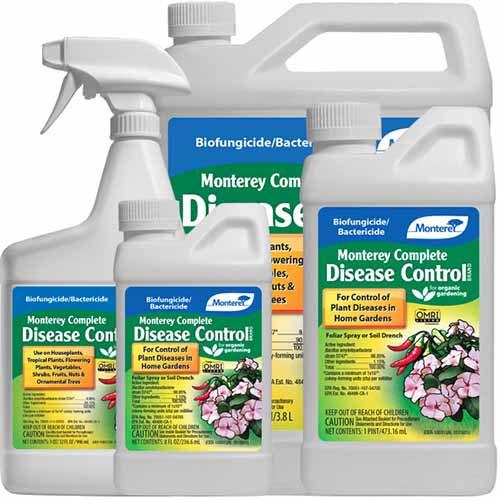

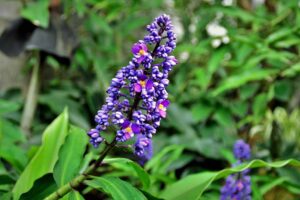
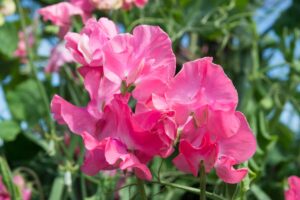
This is a palling this article is ridiculous I did not appreciate your little jokes and speculation about milk and cookies and how this affects people throwing a tantrum good gosh just leave the information for goodness sake’s
Ok Karen. Calm down. It’ll be ok. Promise. If you need to talk to the manager, that would be me.
It seems you’ve missed the point, Melinda! Spraying plants with milk really does help to combat powdery mildew. And we find a sense of humor often helps gardeners to deal with setbacks!
I’ve never visited this site before but I’ve got this powdery mildew on my roses and I found this article quite helpful. I didn’t mind the levity at all; in fact, the only thing I found appalling was your spelling and grammar.
My first climbing rose is beginning to get covered in powdery mildew. I have knockouts 50 feet away and they’ve never been a problem. I’m worried about this climber. She started out so strong and beautiful. Now not so much. Treating with Neem oil helps but it keeps coming back. I’m thinking it needs clearing out around the base ?
Hi Jeff, Knock Outs are some of the most powdery mildew resistant roses out there, so no surprise that they’re fine. Neem oil helps, but I find it isn’t as effective as something that contains potassium bicarbonate or Bacillus subtilis. If you start early and spray the moment symptoms show up, you can eliminate the disease. Otherwise, if the disease has already progressed, anything you use will primarily prevent it from spreading any further and it will return once you stop spraying. You might need to spray every few weeks during the summer. If this climber is your only other… Read more »
This milk tip is great! Will it work for zinnias?
It will! Read more in our guide to homemade and organic remedies for powdery mildew.